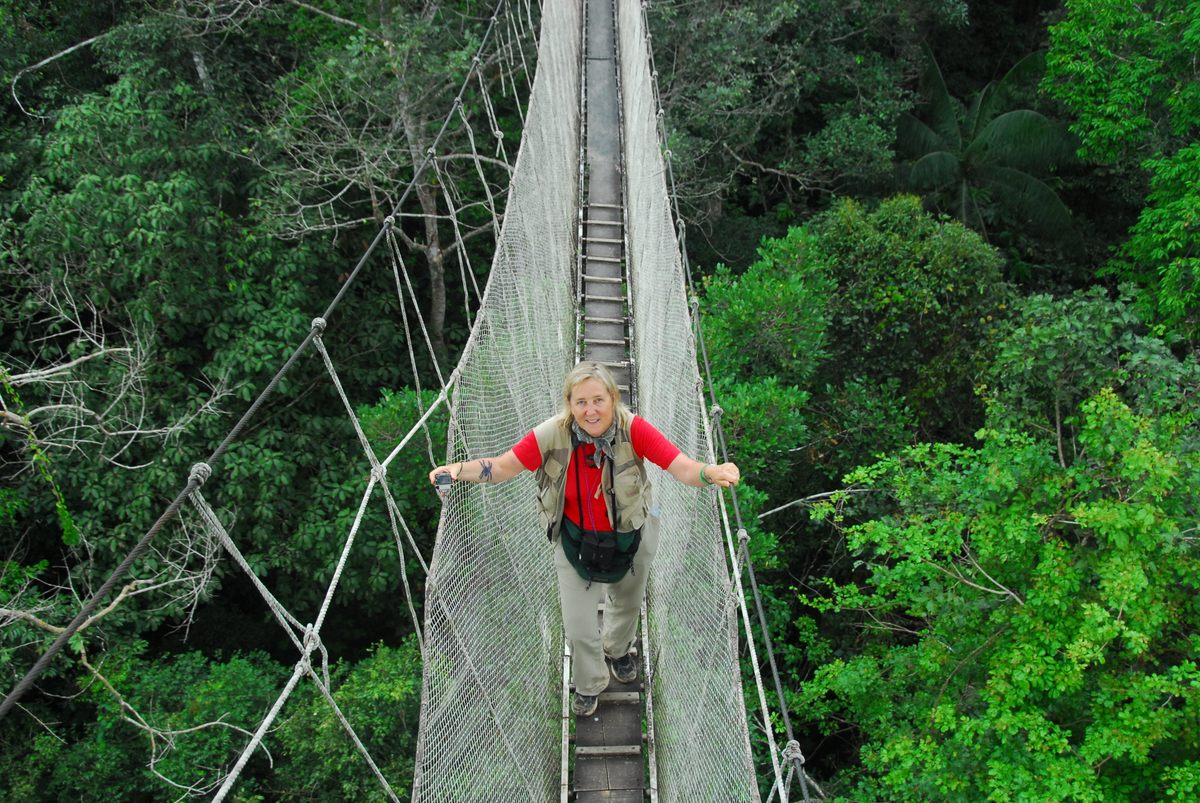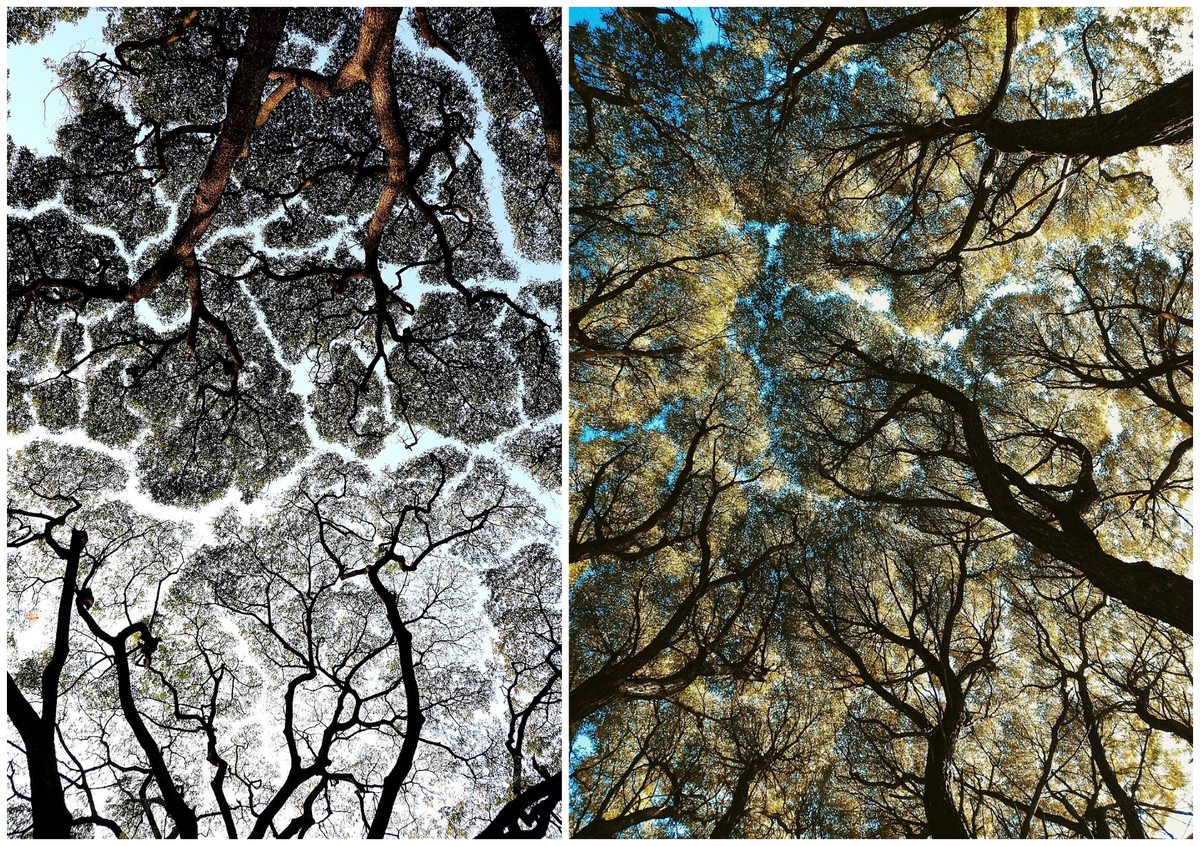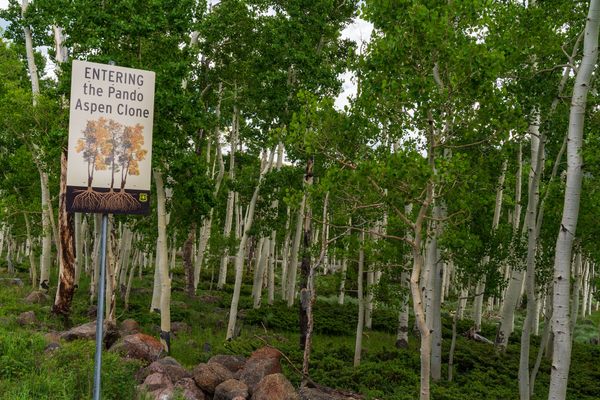Trees Have Their Own Way of Social Distancing
A treetop expert explains the mystery of “crown shyness.”
For most of her young life, Margaret “Meg” Lowman, a forest canopy specialist and self-described “arbor-naut,” looked up at the treetops from the ground. It wasn’t until she traveled to Panama for a research trip that, perched on a canopy access crane that belonged to the Smithsonian Tropical Research Institute, she was able to get a bird’s-eye-view. The alternate perspective showed her something striking: The highest layer of the forest canopy wasn’t a uniform layer of green, but a patchwork of green islands separated by rivers of empty space.
What Lowman witnessed is a phenomenon called crown shyness, which describes the gaps that trees maintain between their top-most branches. From below, this sometimes creates a beguiling, seemingly backlit geometric pattern against the sky. First appearing in scientific literature in the 1920s, crown shyness has now been studied and observed in forests around the world, mostly in trees of the same species: lodgepole pines in British Columbia, Australian eucalyptus, Malaysia’s Borneo camphor, Sitka spruce, Japanese larch.
Although there are many different theories, Lowman believes that trees have adapted to protect themselves and the collective forest from pests, diseases, and severe winds and storms. In this sense, she says, crown shyness has an uncanny similarity to the social distancing that has helped slow the spread of the novel coronavirus. Atlas Obscura asked Lowman what humans can learn from trees about adaptation, communication, and collective health.
You’ve been described as a “Real-Life Lorax” and “Canopy Meg.” What drew you to study trees and their canopies?
I played outdoors since about age three, growing up in very rural upstate New York. There were no movie theaters or computers or cell phones, so nature was our playmate. I just learned to love nature that way, and I’ve been very focused on trees because they’re a home for so many things. They’re such an important piece of keeping us alive.

What exactly is crown shyness?
I would describe crown shyness as the tree equivalent of social distancing! Leaving space between you and your next neighbor because it’s going to enhance your health. It’s a tree’s way of keeping healthy.
Can you tell me about the first time you saw this phenomenon in person?
I probably saw it all the time as a kid, but I never knew what I was looking at. When I finally got to graduate school in Australia, I had my first exposure. I spent most of my time in the canopy, not looking up at it. But when I started reading and doing expeditions to the Amazon, which I’ve been doing for 25 years, I did a lot more training in the understory and looking up. That’s when I really became aware of it. It’s more extreme in the tropics.
I was very interested in trying to figure out how insects get between trees. That’s my expertise, actually: insect-plant interaction in canopies. Half of the biodiversity on the land part of our planet is estimated to live in the treetops… beetles, caterpillars, moths, butterflies, flies, walking sticks. So we have this extraordinary group of insects that focus exclusively on foliage, and they have a big salad bar in the sky. The leaves can’t get away.
If you’re a tree, and you can’t run away from your enemies who are trying to eat you up, one good thing to do would be to try to minimize their ability to get to you. And I think crown shyness is a perfect example: The gaps minimize any chance of insects traveling between them. It also minimizes the physical damage caused when the wind blows hard. It’s gonna knock those leaves and branches together and probably cause a lot of physical damage if they’re really interlaced. So it makes a lot of sense to allow their leaves, which are the energy machines of the tree, a little bit more space.
Some scientists have also theorized that crown shyness allows more sunlight and energy resources to be shared with the lower canopy.
Possibly. There are a lot of ways that trees maximize their ability to give light to lower foliage. A lot of trees have an architecture that allows sunlight to move between the leaves and the branches. I think it’s more about protecting from damage and protecting from insects and predators. If it really was to let light into the understory, there would probably be a lot bigger spaces than what there are.
Where has crown shyness been observed around the world, and in what species of trees?
I’ve seen it in the sassafras tree in Australia, the cardboard tree in Africa. I’ve seen it in some of the montane oak trees in Costa Rica. Because I’m an “arbornaut,” I probably look up at the canopy more than most people. But it’s not [always] something you’re sure to see, because of the layers of the understory and whatnot. There’s a special structure for a forest called a cathedral forest, where the forest has lost its understory and the big, giant canopy trees kind of over-arch, and those are the places where people tend to photograph crown shyness.
But I’ve also seen plenty of forests where I haven’t observed it. The interesting thing is that with younger forests—say, with trees growing up in the understory that have been the result of some selective logging or clearing—you might not be able to observe it from the ground. So I’m not saying that it’s not there, but I’ve certainly been in forests where I couldn’t photograph it, or wasn’t aware of it.

So then it could also be more prevalent in old-growth forests than new-growth?
Right! And I would think yes, because the older trees would be much more adapted. The younger trees are sometimes growing really fast to get to the light, and they might not strategize about worrying about herbivores or wind so much.
Are there other ways that trees have evolved to communicate, protect, and support each other?
There are a lot. Of course, there’s a whole literature on the chemicals, the volatile oils that leaves exude. When they’re eaten, for example, they release some of these volatile compounds that warn and communicate to the neighboring trees, Hunker down! Get your leaf chemicals ramped up because things are eating us! And then there are, for some species, underground mycorrhizal fungal associations and networks. The bite triggers a reaction in the leaf, which in turn engages the survival of the species.
Could this natural example of social distancing inspire us to cope with quarantine and work together as a collective?
I hope so! We’re starting to be aware of the complex communities that older trees provide for the world, for the health of our planet. Old trees support whole communities, they store carbon more than young trees. I think that the more people use trees as mentors and inspiration—going out into nature and seeing how trees cope and thrive, regardless of different situations—the better it is for all of us. There’s so many mysteries about trees, even though they grow all around us, and helping demystify trees and forests is going to be a great way to keep our planet healthy.
This interview has been edited and condensed.



























Follow us on Twitter to get the latest on the world's hidden wonders.
Like us on Facebook to get the latest on the world's hidden wonders.
Follow us on Twitter Like us on Facebook